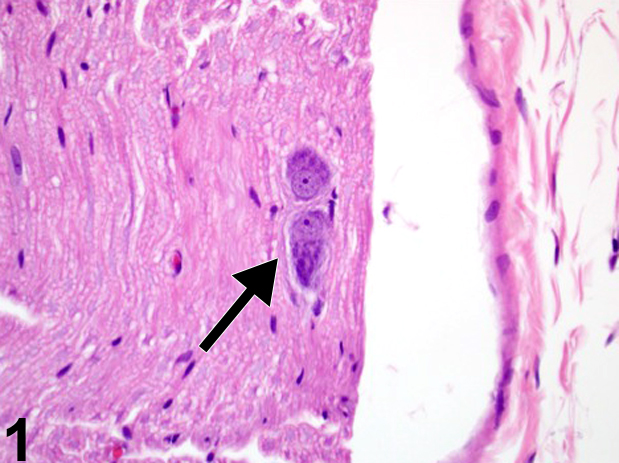Nervous System
Nerve - Ectopic Neuron
Narrative
Comment:
Neural dysplasia describes a wide variety of developmental abnormalities, of which abnormal positioning of neurons (heterotopia and ectopia) is frequently a component. Although neuronal ectopia is seldom recognized as a treatment-related effect in general toxicity studies, the advent of generational studies necessitates the recognition of such malformations of neural development. Substantial neuronal ectopias may result from radiation exposure to embryos. Figure 1 represents a form of abnormal neural development, an incidental finding in this case. Note the ectopic neurons (arrow) in the sciatic nerve. The neurons, probably of ganglionic origin, are misplaced in the body of the sciatic nerve. Note the prominent cytoplasmic Nissl substance (aggregations of rough endoplasmic reticulum) and eccentric positioning of the nuclei. The latter are often associated with minor neuronal insult that affects cytoskeletal integrity, thus influencing the position of the nucleus. Neuronal ectopia is more commonly found in the cerebellum, where Purkinje cells may be located in the granule cell layer or other sites. These, however, should be distinguished from Golgi interneurons of the granular cell layer, which are commonly mistaken for displaced Purkinje cells. There has been no correlation between such neuronal ectopias and clinical neurologic findings in rodents, although it is not possible to rule out that prospect.
Recommendations:
Neuronal ectopia should be diagnosed and the subsite area included when possible in NTP studies. Severity grading is not required.
References:
Ferrer I, Santamaria J, Alcantera S, Zujar MJ, Cinos C. 1993. Neuronal ectopic masses induced by prenatal irradiation in the rat. Virchows Arch A Pathol Anat Histopathol 422:1-6.
Abstract: http://www.ncbi.nlm.nih.gov/pubmed/8438554
Ectopic neurons (arrow) in the sciatic nerve in a male Sprague-Dawley rat from a 30-week study.


